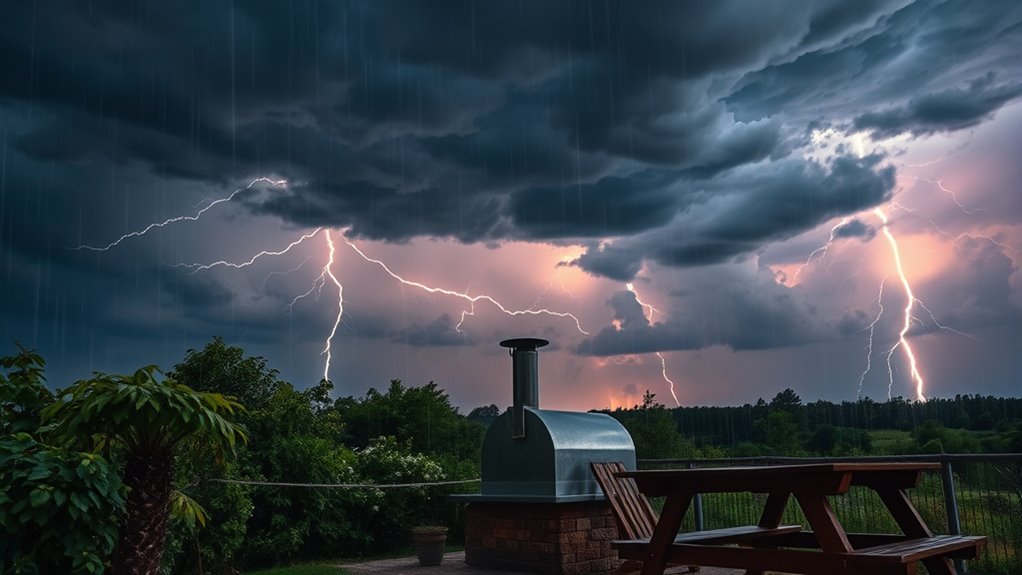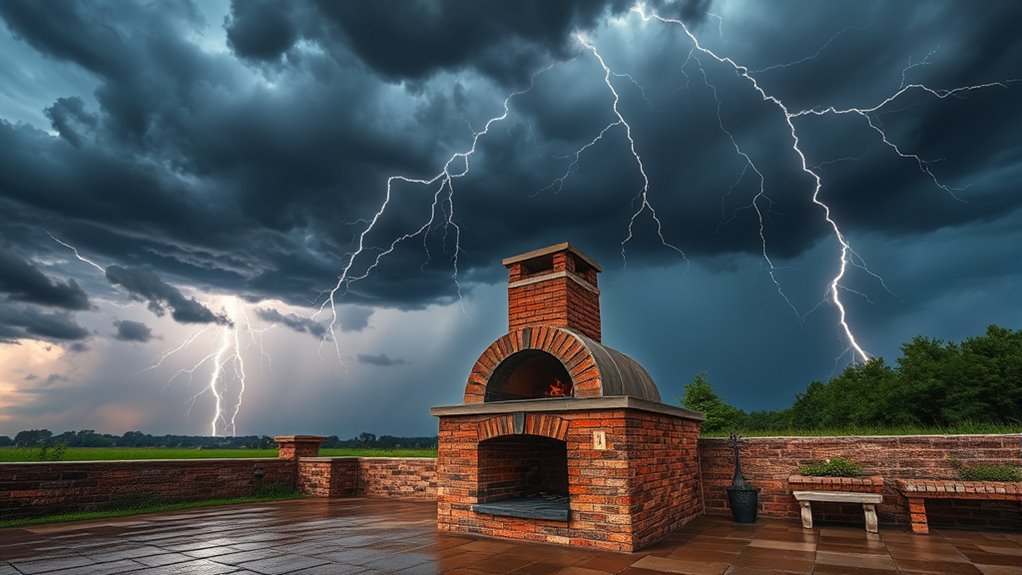To stay safe during storms with outdoor ovens, guarantee your unit is properly grounded by installing a grounding rod or verifying existing wiring—this helps prevent electrical shocks and fire hazards caused by lightning strikes. Disconnect the oven and other outdoor electrical devices before storms arrive, and stay inside a sturdy shelter. Keep monitoring weather updates, and act quickly to protect yourself. If you want to know more about grounding methods and storm safety tips, keep exploring the guidelines below.
Key Takeaways
- Disconnect outdoor oven from electrical power before storms to prevent electrical hazards.
- Ensure proper grounding of the outdoor oven using grounding rods or verified grounding wires.
- Develop and follow a storm emergency plan, including nearby shelter locations and safety procedures.
- Monitor weather alerts and cease outdoor activities immediately when lightning or thunder is detected.
- Avoid handling or moving outdoor electrical equipment during storms to prevent electrical shocks or damage.

Outdoor ovens can enhance your cooking experience, but thunderstorms pose serious safety risks. When lightning strikes nearby, it’s vital to prioritize safety and prevent accidents. One of the most effective ways to protect yourself is by understanding grounding techniques. Grounding involves creating a safe path for electrical currents to travel into the earth, reducing the risk of electrical shock or fire. If your outdoor oven is connected to any electrical components or wiring, ensure it’s properly grounded according to local electrical codes. This might mean installing a grounding rod or ensuring existing grounding wires are intact and functioning correctly. Proper grounding not only keeps your oven safe during storms but also safeguards other outdoor electrical devices.
In addition to grounding, having a well-thought-out storm emergency plan is essential. Before storm season arrives, prepare a plan that clearly outlines what you’ll do if thunderstorms threaten your outdoor cooking space. This plan should include identifying the safest shelter nearby, such as a sturdy building or a designated storm shelter, where you and your family can take cover quickly. Make sure everyone knows how to get there swiftly, and keep emergency supplies—like flashlights, a first aid kit, and a charged cell phone—within reach. Avoid staying outside during thunderstorms, especially when lightning is active, as it can strike unexpectedly and cause severe injuries or damage to your equipment.
It’s also wise to keep an eye on weather forecasts and alerts. Many apps and weather services now provide real-time updates, so you can stay informed about approaching storms. As soon as you hear thunder or see lightning, it’s time to act. Never attempt to move or shut down your outdoor oven during a storm; instead, disconnect it from electrical sources beforehand if possible. Once you’re in a safe location, wait at least 30 minutes after the last clap of thunder before resuming outdoor activities. This cautious approach helps prevent lightning strikes from causing harm. Additionally, understanding grounding techniques is crucial for electrical safety during storms.
Frequently Asked Questions
Can Outdoor Ovens Attract Lightning Even Without a Storm Nearby?
Your outdoor oven can attract lightning even without a storm nearby because of lightning attraction, especially if it’s made of conductive materials like metal. While storm proximity increases the risk, lightning can strike objects that stand out or are tall, regardless of visible weather. It’s best to avoid using your outdoor oven during any storm activity or when there’s a threat of lightning nearby to stay safe.
Is It Safe to Use an Outdoor Oven During a Thunderstorm if It’s Covered?
It’s not safe to use your outdoor oven during a thunderstorm, even if it’s covered. Ironically, the cover offers little protection from lightning strikes. Always prioritize indoor safety and keep an eye on weather monitoring updates. Storms can be unpredictable, and lightning can strike even through coverings. So, delay your outdoor cooking until the skies clear and guarantee your safety first—your oven can wait.
What Are the Signs of a Lightning Strike Near My Outdoor Oven?
You can tell a lightning strike is near your outdoor oven when you see sudden, bright lightning flash patterns and hear loud thunder. Keep an eye out for cloud-to-ground strikes, which indicate lightning is striking close by. If you notice these signs, it’s safest to stop using your outdoor oven immediately, seek shelter, and avoid open areas until the storm passes. Staying alert helps prevent lightning-related accidents.
How Long Should I Wait After a Storm Before Using My Outdoor Oven Again?
You should wait at least 30 minutes after the last lightning strike or storm to use your outdoor oven again. Storm damage or high lightning frequency can increase the risk of residual electrical issues or structural damage. Keep an eye on weather updates, and only resume cooking once the storm has fully passed and it’s safe. Always prioritize safety, and don’t rush back outside too soon after a storm.
Can Electrical Components in Outdoor Ovens Be Damaged by Lightning?
Like a knight protecting their castle, you must safeguard your outdoor oven’s electrical components. Lightning can cause electrical surge damage if your oven isn’t properly grounded and equipped with surge protection. Without grounding safety and surge protectors, lightning strikes could fry sensitive parts, leaving you with costly repairs. Always guarantee your outdoor oven has proper grounding and surge protection; this keeps the electrical components safe and prevents damage during storms.
Conclusion
Remember, safety always comes first when using your outdoor oven during storms. Keep an eye on the weather and have a plan to quickly move to shelter if lightning threatens. Don’t wait until it’s too late—it’s better to be safe than sorry. Storms can turn quickly, so stay alert and don’t push your luck. After all, it’s better to be safe than to learn the hard way; you don’t want to be caught in the lightning’s path.









